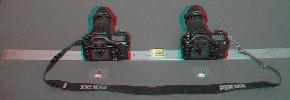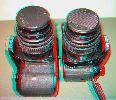Messages on Anaglyphs group
Post on Anaglyphs group
Viewed
 (134K)
(134K) (102K)
(102K) (181K)
(181K) (153K)
(153K)
----- Original Message -----From: JucarbiSent: Thursday, February 14, 2008 3:48 AMSubject: Re: [Anaglyphs] Marshall/Duke-Icy night Thanks for your replies. I've recently twinned two K10's on a bar. Haven't had much success as yet. Will persevere and try using the delay. These have a remote sensor on the rear but I haven't experimented with triggering both yet.
Jay
----- Original Message ----
From: Marshall Rubin <mrubin(-at-)hvc.rr.com >
To: anaglyphs(-at-)yahoogroups.com
Sent: Wednesday, 13 February, 2008 11:38:17 PM
Subject: Re: [Anaglyphs] Duke-Icy night
Some digital cameras come with remotes. If the infrared sensor is in a convenient spot on each camera, both can be tripped using onlyone of the remotes. If the IR sensors are in the back of the cameras (most unlikely) it becomes easy to set then off. If in the front, so long as they are on self-timer,both cameras can be set off with the remote, then you quickly pull the hand back behind the cameras, and wait for them to go off. If the cameras allow for somedegree of manual controls, pre-set the cameras for the fastest shutter speed possible. This technique works even better when the cameras and twin bar aremounted on a tripod.Beware, for even under the best of conditions, some moving object, like a damn bird will fly across the sky during the dual exposures, and only appear in one of the chips. Sometimesthat can be removed later in an image editor like Photoshop.Marshall----- Original Message -----From: DukeSent: Wednesday, February 13, 2008 1:33 AMSubject: Re: [Anaglyphs] Duke-Icy nightThe idea is to press both shutter buttons at the same time. When shooting in such low light as in this shot, the shutter speed is fairly long (I think it was about 1/6 sec). Pressing both buttons with some degree of force would shake both cameras and cause blur at this slow speed. If you use the 2-sec timer delay, it doesn't matter if you shake the cameras at the time of the presses, the pictures aren't taken until two seconds later. This gives me time hold the bar-mounted cameras as still as possible until the shutters open. Any residual unsteadiness in my hand is (hopefully) eliminated by the optical image stabilization in the cameras.If I didn't do it this way, there is no way I could get a sharp hand-held picture at 1/6 second (or without the image stabilization) . If the cameras were mounted on a tripod, it would be a different story. However, I think I would still use the 2-sec delay to insure that I didn't shake the cameras when pressing the buttons. Finger-syncing two cameras is difficult with a light, easy push. It has to be more deliberate to make sure the presses are as simultaneous as possible.Hope this made some sense!Duke
On 2/13/08, Jucarbi <jucarbi2005(-at-) yahoo.com> wrote:Looks really slushy. I don't understand the "finger-synch (w/2-sec.timer) " Why did you do that?
Jay
----- Original Message ----
From: Duke <stereospace(-at-) gmail.com>
To: anaglyphs Yahoo <anaglyphs(-at-)yahoogrou ps.com>; Exchange Domeus <stereo-photography(-at-) domeus.co. uk>
Sent: Wednesday, 13 February, 2008 3:27:08 PM
Subject: [Anaglyphs] Icy night
My car in my driveway with freezing rain falling after an earlier snowfall.Panasonic Lumix twins, finger-sync (w/2-sec. timer), SPM, Photoshop.Duke
--
a.k.a. Dimensionally Demented Duke
Get the name you always wanted with the new y7mail email address.
--
a.k.a. Dimensionally Demented Duke
Get the name you always wanted with the new y7mail email address.